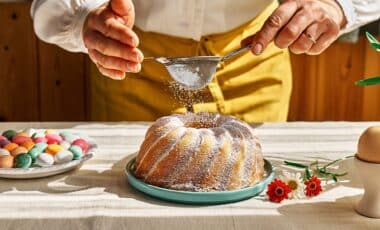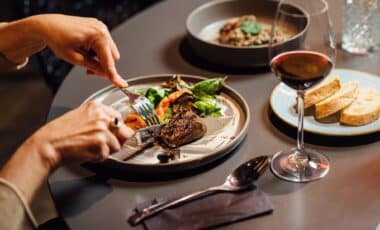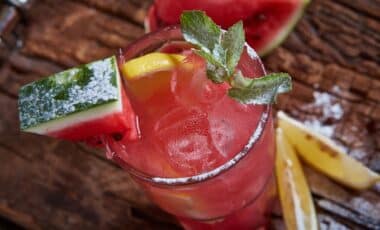
For the last two and a half years, Bangkok fans of chef David Thompson have been eagerly waiting for him to return to the capital with a full service restaurant. The opening of Aksorn, his new eatery on the top floor of a sleekly refurbished shophouse in Charoen Krung, Bangkok’s oldest paved street, has brought that wait to an end. But the stylish 40-seater with an open kitchen is not the place that the chef set his sights on when he left his trailblazing Thai restaurant that had wowed guests first in London and then in Bangkok, picking up a Michelin star in each city along the way.
“I walked out of a very successful restaurant called Nahm,” says Thompson with characteristic candour. “I refused many other possibilities.” After Nahm, he did open Someday Everyday, a short-lived khao gaeng joint—cooked dishes over rice—but it never really found a following.
 Thompson drew inspiration from the recipe collection by Thanpuying Klib Mahithorn
Thompson drew inspiration from the recipe collection by Thanpuying Klib Mahithorn 
Even as he stepped up to receive his star for Nahm, it was an open secret amongst Bangkok’s close-knit dining scene that his new restaurant would be perched high atop Mahanakhon, then the city’s tallest building. It was supposed to be the tower’s crown jewel called MahaNathi meaning ‘great tributary’, a playful jab at the moniker of his previous home Nahm, plain old ‘water’ in Thai. But in a series of highly publicised moves the building changed hands and the flagship hotel that was to have hosted the restaurant was rebranded not once but twice. “I could have rested on my laurels,” he admits looking back, “But I think Nahm was nearing the end of its time.” He pauses. “It probably wasn’t, but it was near the end of my interest in it.”
At the same time, Central Retail Group’s Barom Bhicharnchitr approached him to open what would become Aksorn. “I’m sure he tried two or three other people first then went straight to the bottom of the barrel and found me,” Thompson quips deadpan. When he saw the plans he felt that the projects would be complementary. Small, personable and quirky Aksorn seemed to be a perfect foil for the large-scale, tourist-oriented operation. “It was just far enough away from Mahanakhon but not too close to be competition,” he says.
 Trying out the new recipes in the kitchen
Trying out the new recipes in the kitchen
And with that, he accepted the offer to run the restaurant in Central: The Original Store, the massive retail group’s homage to its roots as the pioneer importer of books and magazines that also houses a café, a music venue, retail space, a research library and an exhibition space dedicated to the company’s past. “This was my stupidity,” says Thompson coyly. In retrospect it was clearly a good move.
Aksorn’s balcony has a clear view of the skyscraper’s pixelated façade, a reminder of the awkward situation he is now glad to have escaped. When the latest management company took over the location in Mahanakhon with the remit to install a young, hip, American boutique hotel brand, Thompson felt he no longer had a place there. “It was an ill fit,” he says. They parted amicably, almost exactly two years after MahaNathi was first slated to open.
Meanwhile Covid was also making itself felt, delaying the opening of Central’s shophouse. “I’d resigned myself to this sudden decline,” recalls an ironic Thompson, referring to the semi-lockdown that saw many of Bangkok’s businesses grind to a halt. “The downward spiral of my career from restaurateur of some repute to becoming my cat’s concierge, my pussy’s doorman. I was left alone with only a meow and a scratch, away from the din and demands of kitchens, cooks, customers and restaurants. Halcyon days when I look back on them now,” he says with faux nostalgia. “I had to reconsider my priorities.”

Other than catering to his moggy’s whims, lockdown also gave Thompson time to develop menus and study source material. “I tried to work out what could be done,” he explains. “[The original Central store] is a bookshop from the 1940s, 50s and 60s. It screamed to me that I should use the types of cookbooks I’d never used before from the same period that I’d always disdained as being not as interesting, not as ornate, not as original, not as authentic, not as fascinating as food from an earlier era.” His assessment couldn’t have been further from the truth. “I thought it was just regular stuff that didn’t have a distinctive personality. And I was wrong.”
His first menu draws inspiration directly from the recipe collection entitled Side Dishes to Teach Children by Thanpuying Klib Mahithorn. “Her food is quite distinctive, really cooky stuff.” The wife of Maha Sawak-Ek Chao Phraya Mahithorn—one of the last Chao Phrayas of Siam—was born in 1876 and died in 1961, meaning she witnessed all the major political and social changes of the early 20th century. “She was born in a palace, as they all were; she was a mixture of Lao, Chinese and Thai, as they all were. She saw the transition from Siam to modern Thailand,” comments Thompson. Her life began at the height of regal cuisine and ended as families embraced respectably middle class home cooking. “She seems the ideal candidate to kick off Aksorn,” he says.
Thompson plans on dipping into a different period cookbook every two months. “One of the things I’d love to do is set up a library not just of my books but a few other people to have a thousand volumes so that Thais can enjoy their own cuisine,” he enthuses. “Some of these books moulder away on shelves, rarely used. And that’s such a shame because there is a trove of recipes.”


Airy open-plan Aksorn, designed by Kunichi Nomura of Tokyo interior design studio Tripster, plays on the modern in looks but not necessary on the plate. Much of the mismatched crockery looks as if it has just come out of granny’s credenza. “What we’re trying to do here is not my interpretation of Thai food but to get a little closer to these people, be a little more faithful,” says Thompson about this overlooked period in Thai culinary history. “There are so many things here that are interesting that you just don’t see any more.”
Among them, the chef sends out a spiced pork galantine seasoned with five spice like a palo and set in its own gelatine; a spicy smoky grilled tomato salad that concentrates the taste of the fruit, a relish, garnish and side dish rolled into one; and a distinctive red beef curry with layers of flavour and texture that place it beyond the spheres of a run-of-the-mill kaeng phet or massaman. The current menu includes 13 dishes. “We’re trying to be as organic as possible, as local as possible, as seasonal as possible,” says Thompson. “I’ve embellished it a little bit,” he adds, pointing to the inclusion of hors d’œuvre and desserts that were not typical of meals at the time. The mains are served kap khao mode, multiple dishes served family style with rice.
Bangkok is not the only place to sample Thompson’s food. Off the coast of Koh Samui, Long Dtai in the exclusive private island resort of Cape Fahn dishes up the heady flavours of the south. “We’re quite a busy restaurant compared to others on the island,” notes Thompson with satisfaction. He also has his hand in Arundina in the Tubkaak Boutique Resort in Krabi. “It is a charming place, a wonderful little hotel with Thai owners who want to do something uniquely Krabi,” he explains. He prides himself on serving local recipes made from all local ingredients. “The shrimp paste is different, the fish sauce is different. We’ve got local rice; it’s a rich culinary culture.” He singles out the tom kati with bamboo cooked in coconut milk with turmeric, chilli and black pepper: “It’s just delicious.”

Meanwhile his restaurants around the world continue to trade, despite the challenges of the health crisis. “Many upmarket Thai restaurants are not doing well,” he notes. Aaharn in Hong Kong, which won its first Michelin star last year, has survived the storm as have his Long Chim restaurants in Australia. “Perth is doing better than Sydney,” he says. “But we’ve lost no restaurants.”
The chef acknowledges that in Thailand there is still reticence in some quarters to shelling out top baht for what some consider ‘just’ local food. “I think that Thai food has so much to offer. It uses good ingredients that are comparatively expensive. I’ve always thought that Thailand has that capacity [for quality]. As a cook isn’t that what you aim for?” He also sees that some people are still sceptical of an Australian chef who is an authority on Thai cuisine. “I understand that. I’d be sceptical too. Absolutely.” But his most convincing argument is getting people to try his food to dissipate any doubts. “I’ve paid my dues. There was a controversy when I began. My god, I thought I was going to be tarred and feathered. And chopped and fried and eaten with nam prik!” he jokes irreverently.
These days Thompson’s background isn’t an issue and local appreciation for the range that Thai cuisine can offer has arrived. “Acceptance has come. I weathered it. I did what I believed in,” he smiles. Three decades of experience inside and outside of Thailand obviously have something to do with that. But what impression does he want guests to leave Aksorn with? “I want you to be comfortably full, wanting to come back, thinking you’ve had a good time.”
Aksorn
1266 Charoen Krung Road
Open Tuesday-Sunday 6-11pm
02-116-8662, aksornbkk.com
More Tatler reviews: The Sage Advice Of Salvia Italian Restaurant







